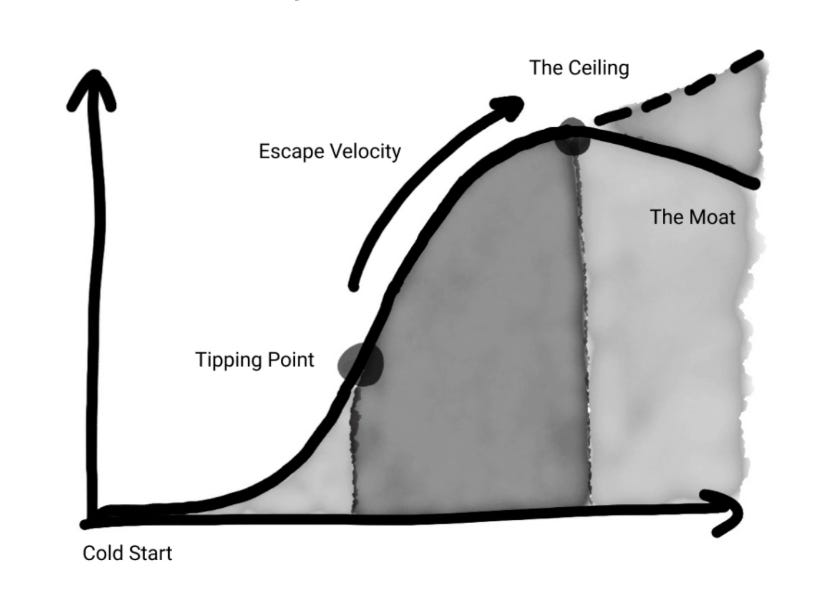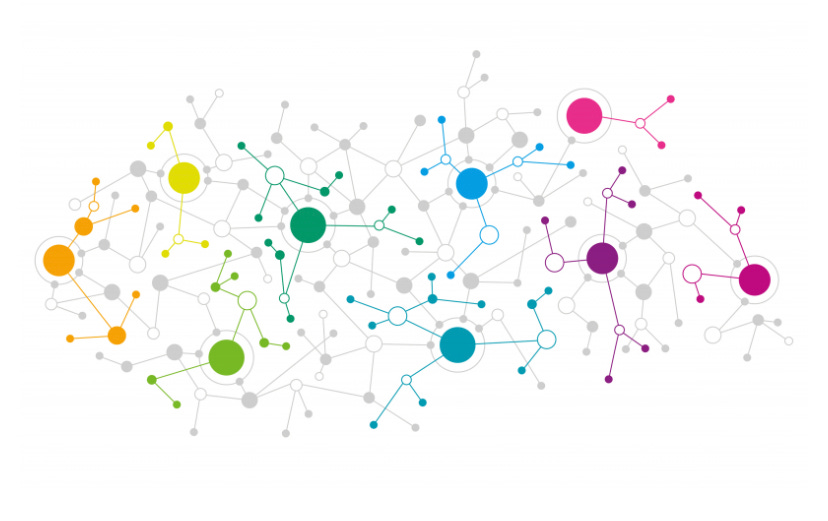(Read web version.)
The network effect describes a situation where a product becomes more valuable as user numbers grow. When the telephone was introduced 140 years ago its value to users increased rapidly as more people joined the network. Many of the world’s most popular and valuable apps, including Facebook, Twitter and Uber, have effectively exploited network effects.
This post draws upon Andrew Chen’s framework, presented in his book The Cold Start Problem, to help app developers understand and optimise network effects to grow their user base. The main focus will be on the first and, arguably, the most important stage of the framework, the Cold Start, which lends its name to the book title.
Stages
There are five stages for creating, growing and defending a network based product which are:
Cold Start - Establish first self sustainable atomic network.
Tipping Point - Establish further atomic networks (like domino toppling).
Escape Velocity - Acquisition, Engagement and Economic effects.
The Ceiling - Hitting potential growth limits.
The Moat - Fending off competitors.
Cold start
If someone went onto a video sharing app and there were no videos of interest to view then they would quickly leave. The same is true of any network based app where providers and consumers of content or services come together. To get through the Cold Start Problem requires that the right users and content are on the network at the same time. Most network products fail because they do not achieve this.
Atomic networks
It is necessary to establish an Atomic Network - the smallest network that is stable and can grow on its own. The size and nature of the atomic network required will vary from one app to another, e.g. Zoom’s is just two people and Airbnb is around 300 properties. App developers should consider what the size and characteristics are of atomic networks for their apps, e.g. my Chairing.it app (for meetings) requires 2 users for it to be useful.
Focus on the hard side of the network
There is often a hard (more challenging) and easy to establish side to networks. For Tinder the hard side is women, for Uber it is drivers and Airbnb it is property owners. The prime focus should be to address the hard side of the network first, e.g. Uber offered significant financial incentives for drivers to use their app. Reddit’s initial content providers were the founders themselves.
Tipping point
Once an initial atomic network has been established then subsequent atomic networks are required to grow the user base. Each successive atomic network should be easier and faster to setup than the previous, akin to cascading dominos. Tinder established atomic networks around universities, followed by cities, then regions and countries. Uber did it city by city. This second stage is the Tipping point.
Escape velocity
A common misconception is that once network effects kick-in for a product that the path to market domination is assured. However, this is often when tech companies hire many people and launch multiple projects in an attempt to maintain rapid growth. This Escape Velocity stage is driven by three effects.
Acquisition effect
Positive early experience that encourages users to invite others which drives cost effective, viral growth. LinkedIn’s connection recommendations is an example of this.
Engagement effect
Increased user engagement as the network grows. Uber moved users up the engagement ladder from airport trips, to dining out to daily commutes.
Economic effect
Increased revenue per user and improving other financial metrics over time. As more friends join the game, Fortnite is able to sell more customised costumes and guns to players.
The ceiling
A rapidly growing network experiences significant forces, some of which drive positive growth while others act to destroy it. This is when the network hits the ceiling and growth can stall. User acquisition costs can rocket (due to market saturation), fraudsters can become active, there can be overcrowding and the user experience can suffer. Initiatives can be established to address these issues as they arise, but they become progressively more challenging over time.
The moat
The final stage of the framework focuses on using network effects to fend off competitors as the product and market matures. One problem for the dominant party, trying to defend its network, is that smaller attackers can exploit the same network effects inherent in the market. The upstart typically tries to pick off a niche segment of the market and build a defendable atomic network. The incumbent uses its larger size to drive better monetisation from and higher value for its top users.
Other resources
The Cold Start Problem - Talks at Google by Andrew Chen
How to solve the cold start problem for social products by Andrew Chen
This post explored a framework to consider and exploit network effects for apps. In next Sunday’s post I’ll share the approach I took to designing icons for some of my mobile apps, including Aim For.
Until next Sunday, consider the characteristics of atomic networks for mobile apps you use or, maybe, consider developing.
Phil…





